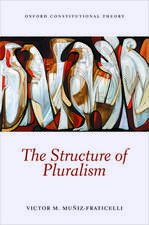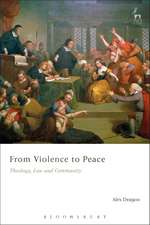Sensing Law: Social Justice
Editat de Sheryl Hamilton, Diana Majury, Dawn Moore, Neil Sargent, Christiane Wilkeen Limba Engleză Paperback – 15 iun 2018
| Toate formatele și edițiile | Preț | Express |
|---|---|---|
| Paperback (1) | 303.43 lei 6-8 săpt. | |
| Taylor & Francis – 15 iun 2018 | 303.43 lei 6-8 săpt. | |
| Hardback (1) | 850.17 lei 6-8 săpt. | |
| Taylor & Francis – 21 noi 2016 | 850.17 lei 6-8 săpt. |
Din seria Social Justice
-
 Preț: 394.37 lei
Preț: 394.37 lei - 8%
 Preț: 382.47 lei
Preț: 382.47 lei -
 Preț: 309.23 lei
Preț: 309.23 lei -
 Preț: 280.29 lei
Preț: 280.29 lei -
 Preț: 325.72 lei
Preț: 325.72 lei -
 Preț: 311.41 lei
Preț: 311.41 lei -
 Preț: 350.12 lei
Preț: 350.12 lei -
 Preț: 413.18 lei
Preț: 413.18 lei - 18%
 Preț: 1013.72 lei
Preț: 1013.72 lei -
 Preț: 489.26 lei
Preț: 489.26 lei - 14%
 Preț: 324.67 lei
Preț: 324.67 lei -
 Preț: 318.18 lei
Preț: 318.18 lei -
 Preț: 311.41 lei
Preț: 311.41 lei -
 Preț: 387.10 lei
Preț: 387.10 lei - 18%
 Preț: 998.83 lei
Preț: 998.83 lei -
 Preț: 322.97 lei
Preț: 322.97 lei - 18%
 Preț: 1001.84 lei
Preț: 1001.84 lei -
 Preț: 379.48 lei
Preț: 379.48 lei - 18%
 Preț: 1003.89 lei
Preț: 1003.89 lei - 26%
 Preț: 765.90 lei
Preț: 765.90 lei -
 Preț: 482.94 lei
Preț: 482.94 lei -
 Preț: 409.48 lei
Preț: 409.48 lei -
 Preț: 485.61 lei
Preț: 485.61 lei -
 Preț: 322.97 lei
Preț: 322.97 lei - 18%
 Preț: 1005.48 lei
Preț: 1005.48 lei - 15%
 Preț: 437.52 lei
Preț: 437.52 lei -
 Preț: 369.73 lei
Preț: 369.73 lei -
 Preț: 389.99 lei
Preț: 389.99 lei - 18%
 Preț: 1058.43 lei
Preț: 1058.43 lei
Preț: 303.43 lei
Preț vechi: 343.53 lei
-12% Nou
Puncte Express: 455
Preț estimativ în valută:
58.06€ • 60.62$ • 48.05£
58.06€ • 60.62$ • 48.05£
Carte tipărită la comandă
Livrare economică 04-18 aprilie
Preluare comenzi: 021 569.72.76
Specificații
ISBN-13: 9781138624320
ISBN-10: 1138624322
Pagini: 344
Dimensiuni: 156 x 234 x 30 mm
Greutate: 0.64 kg
Ediția:1
Editura: Taylor & Francis
Colecția Routledge
Seria Social Justice
Locul publicării:Oxford, United Kingdom
ISBN-10: 1138624322
Pagini: 344
Dimensiuni: 156 x 234 x 30 mm
Greutate: 0.64 kg
Ediția:1
Editura: Taylor & Francis
Colecția Routledge
Seria Social Justice
Locul publicării:Oxford, United Kingdom
Public țintă
Postgraduate and UndergraduateCuprins
Sensing Law: Introduction, Sheryl N. Hamilton, Diana Majury, Dawn Moore and Neil Sargent Experts and Translation 1. What It’s Like: Demonstrative Evidence of Subjective Experience, Neal Feigenson 2. Law’s Sensorium: On the Media of Law and the Evidence of the Senses in Historical and Cross-Cultural Perspective, David Howes 3. Seeing the Similarities in Songs: Music Plagiarism, Forensic Musicology and the Translation of Sound in the Courtroom, Michael Mopas and Amelia Curran 4. Visual Logics of Deduction: Ocular Presence and Ocular Distance in Edgar Allan Poe’s "The Purloined Letter", Neil Sargent Bodies 5. How to Make Sense? An Aesthesis of Citizenship and Legitimacy, Anne Quéma 6. Legal Sensibilities and the Language of Gesture in Late Eighteenth-Century British Satirical Prints, Miriam Wallace 7. The Smell of Neglect: A Trans-corporeal Feminism for Environmental Justice, Dayna Scott, 8. Law’s Sense of Smell: Odours and Evictions at the Landlord and Tenant Board, Sarah Buhler 9. Sensing Sexual Assault: Evidencing Truth Claims in the Forensic Sensorium, Sameena Mulla Space, Place and Subjectivities 10. Sense of Place and Spirit of Place in the Schubart Park Case, Isolde de Villiers 11. An Empire of Sound: Sentience, Sonar and Sensory Impudence, John Shiga 12. The Optics of War: Seeing Civilians, Enacting Distinctions, and Visual Crises in International Law, Christiane Wilke Invitations and Exhortations: An Epilogue
Recenzii
‘How does a trial lawyer demonstrate an accident victim's ringing in the ears? What keeps a court system from discerning the significance of ceremonial song and dance in an Aboriginal land claim case? What kind of odour legally justifies a tenant's eviction? These sumptuous case studies show why the time has come for law to face its complex entanglement in the life of the senses.’
Richard K. Sherwin, New York Law School, USA
Richard K. Sherwin, New York Law School, USA
Descriere
A rich collection of interdisciplinary essays, this book explores the question: what is to be found at the intersection of the sensorium and law’s empire? Examining the problem of how legal rationalities try to grasp what can only be sensed through the body, these essays problematize the Cartesian framework that has long separated the mind from the body, reason from feeling, and the human from the animal. In doing so, they consider how the sensorium can operate, variously, as a tool of power, or as a means of countering the exercise of regulatory force.



















